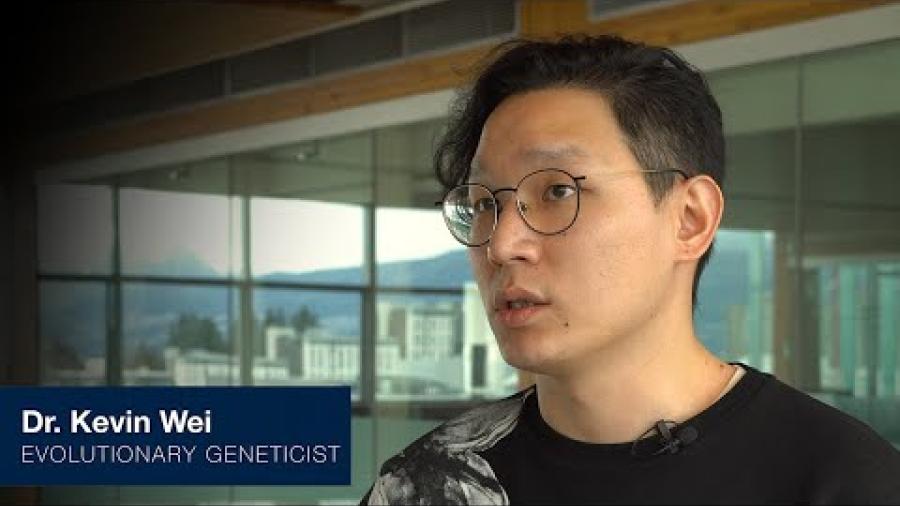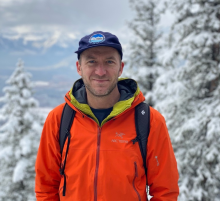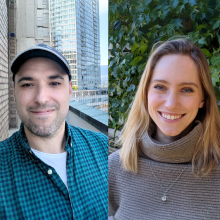
January 1, 2023 marked Dr. Kevin Wei’s first day as an Assistant Professor in the Department of Zoology at UBC. In this edited conversation Dr. Wei discusses his research as an evolutionary geneticist, beginning with the year he spent in Taiwan after getting his Bachelor of Science degree, working as a lab technician studying Drosophila.
Why was your experience in Taiwan so important in your career trajectory? What caught your interest?
To be perfectly honest. I always really enjoyed biology growing up and part of it was that growing up, I thought I was going to med school because that seemed to be the obvious thing to study. But that didn’t happen. What I really enjoy with genetics is how much of it feels like very fun puzzles to be solved. There are some very basic rules in genetics, e.g. independent assortment, yet it is an intricate system that is the basis of life.
What particularly makes me love Drosophila genetics is that you are given all these rules and all these tools to get at the questions you want answered. It is the puzzle aspect of it that I find very attractive. And by solving these puzzles we can get at basic questions about how organisms are formed and how this system is perpetuated, and the evolution aspect of it all.
Do you think you will keep working with Drosophila or will you expand to other organisms?
I do have a soft spot for flies but I’m definitely open to working with other systems. It will probably be dictated by how funding goes. But what we learn from fundamental biology in Drosophila will be readily applicable in mammals, including mice or humans. So I am definitely thinking about taking what we learn from flies and applying some of the methods and ideas in more translatable systems.
Tell us a little more about your work with transposable elements and selfish genetic elements.
In the past, there was this idea that all genes are working together to support life and the host’s fitness— making sure the host organism has functional cells, organelles, organs and body. In actuality, the genome is littered with a lot of “garbage”—DNA that doesn’t seem to have any function—including selfish genetic elements. The major constituents of selfish genetic elements are transposable elements (TEs). We call them “selfish” because they don’t really “care” about the fitness of the host organism. Their primary concern is their own fitness. TEs can replicate in a very unique manner—they self-replicate and move around to increase their copy numbers in the genome. In contrast most genes cannot do that and their success depends on the whole organism’s success. This makes TEs very unique because their interest is not aligned with the that of the host organism. But that’s bad for the whole genome because these TE movements can be highly disruptive. For example, they can jump into a gene and disrupt the gene’s function.
There is this profound antagonistic interaction between TEs and the host genome because of the propensity that they can create genome instability, damages in the DNA, and ultimately to the whole host genome. This is what we call a molecular arms race. Fortunately, the genome has very sophisticated and often redundant mechanisms to suppress TEs from moving around.
Then in turn, TEs can and have evolved ways to evade the suppression and keep jumping around. This creates this loop of TEs evading defenses and the genome updating these defenses and adapting to the new TEs’ mechanisms and so on. Usually, these are mutations causing changes to allow TEs to proliferate and those mutation will then propagate in all their copies. Then, as a response the genome will have itself beneficial mutations in silencing TEs. This is an arms race that doesn’t end—or that we don’t foresee ever ending—between the genome and all these selfish genetic elements that have driven profound changes in the genome. It is in fact a very old arms race that can be found across all life forms.
Are there diseases associates with TEs?
There are several ways this could be disease-causing. For instance, a transposable element jumping into the functional part of a gene can destroy the gene.
There are also a lot of examples of TEs inducing positive change in the genome. There is a fun one recently published: the authors found evidence that in the macaques and apes primate lineage, tails were lost because of a TE insertion. It turned out the TE insertion caused the loss of tails by changing the splice product of a gene needed for tail development. While the TE insertions occurred in a primate lineage, the researchers were able to test the two splice different variants in mice and show that the variant with the TE insertion created mice with shorter tails.
So, while we primarily think of TE activities as either neutral or deleterious, they can also be drivers for novel phenotypes and genotypes in organisms. And that makes TEs really fascinating to me. A good analogy for the “genome full of garbage” would be the like a garage full of junk. Most of the stuff is just sitting there not doing anything. It may not be a good idea to have too much clutter in there because things might topple over—that would be really bad, but then maybe sometimes some of the stuff becomes very useful.
Was there a moment in your career that has determined your direction in research?
I don’t have an aha moment, and no inspiring story that has determined my academic interest. I went to places that I found very interesting and that dictated my next direction. It just progressively got more interesting and that set me on various paths and here I am now. I never had that aha moment or any pivotal event that drove and motivated me. I grew up I playing a lot of video games and had a very typical upbringing and I was not particularly outdoorsy. Not all of us need to have a path determined by particular life-altering events. For me, the love of science and my current interests stems from finding questions like how basic genetic processes work and how the genome is what it is, is inherently interesting. I will be OK if I never cure cancer or save the world—there are people better equipped to do that. I really believe in pursuing science for the sake of accruing knowledge Of course, it’s incredibly important to care about research that can cure diseases and transform lives. But there is also so much value in being curious and wanting to know for the sake of knowing.
What attracted you to UBC Zoology?
One, because I grew up here and this is home for me. Vancouver is a fantastic place to live. From the academic level, UBC is a very unique place for evolutionary biology research and for Drosophila research. There is an amazing combination of faculty in Zoology and the Life Sciences Institute doing fantastic work in Drosophila and world class evolutionary biologists. This makes UBC and Zoology a very unique place with a unique combination for me and I hope to take full advantage of both these strengths.


